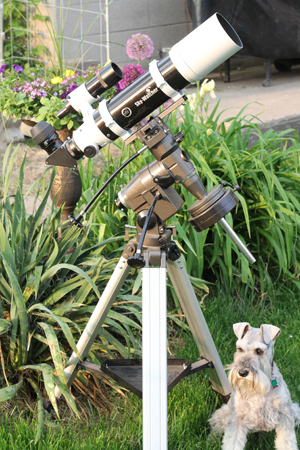 Whether you’re setting up your telescope for the first time after unpacking/assembling it or adjusting it after it may have been bumped out of alignment, knowing how to do this will turn a potentially intimidating device into a lifelong tool that’s a pleasure to use.
Whether you’re setting up your telescope for the first time after unpacking/assembling it or adjusting it after it may have been bumped out of alignment, knowing how to do this will turn a potentially intimidating device into a lifelong tool that’s a pleasure to use.
Adjusting your finderscope
No matter what kind of telescope you have, you’ll want to make sure your finderscope – the little “mini-telescope” attached to the main scope – is aimed properly so you can use it to aim the main scope.
To do this:
1. Take your telescope outside in the daytime with the lowest-power eyepiece (the one with the highest number, in mm – 20 mm, for e.g.)
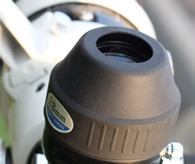 2. Aim the main tube at something easy to find: A house, car, lamp post, or something else far away enough (100-200 feet) that you can focus the main scope on it.
2. Aim the main tube at something easy to find: A house, car, lamp post, or something else far away enough (100-200 feet) that you can focus the main scope on it.
3. For now, you’ll have to do this without the finderscope, nudging the main tube up-and-down, left-and-right until you find that house/car/etc…
4. Once you’ve found your target and focused it, it’s time to aim the finderscope at the same target.
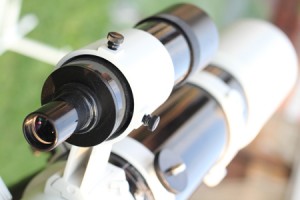 5. Twist the two (or three) screws at the back of the finderscope back-and-forth until the “X” of the crosshairs is centred on the same thing as the main telescope.
5. Twist the two (or three) screws at the back of the finderscope back-and-forth until the “X” of the crosshairs is centred on the same thing as the main telescope.
6. Once this is done, switch to a higher-powered eyepiece (the one with the lowest number, in mm – 10 mm, for e.g.) and repeat step 5, fine-tuning the centreing of the finderscope crosshairs if-necessary.
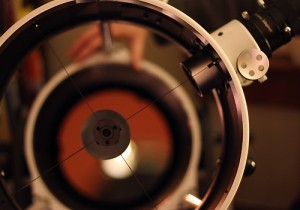 Adjusting your main telescope’s optics (mirror-based “reflector” telescopes only):
Adjusting your main telescope’s optics (mirror-based “reflector” telescopes only):
Though mirror-based telescopes pack more bang-for-your-buck, these larger-aperture scopes are more likely to need the odd adjustment of their main optics.
Whether you’re adjusting (i.e. “collimating”) your reflector’s optics for the first time or after they’ve been bumped out of alignment…
…here’s how you get things up to 100%:
1. Take your reflecting telescope outside and remove the eyepiece
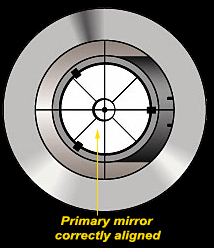 2. Look into the empty focuser – If both mirrors are aligned more-or-less perfectly, you should see your own eye centred in a small circle, which will – in-turn – be centred in a larger circle. (Like in the diagram at right.)
2. Look into the empty focuser – If both mirrors are aligned more-or-less perfectly, you should see your own eye centred in a small circle, which will – in-turn – be centred in a larger circle. (Like in the diagram at right.)
If this is the case, congrats! Go buy a lottery ticket and come back to enjoy the view through your scope when it’s dark.
3. If your telescope isn’t perfectly adjusted, here’s what you’re going to do…
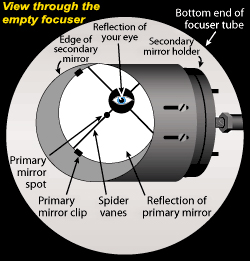
4. Make sure the secondary (small) mirror is centred in the middle of the focuser (i.e. not left, right, etc… under the empty focuser. If it’s centred, great! If not, you’ll need to move the entire secondary mirror assembly up or down the “spider” support vane[s] until it’s centred. (Your scope’s instructions OR this guide can tell you what to adjust to do this.) The diagram at right shows a secondary mirror too far to the left (i.e. the secondary mirror needs to move a little to the right to be directly under the focuser.)
At this point, don’t worry about how the other aspects of this and the primary are or aren’t centred.
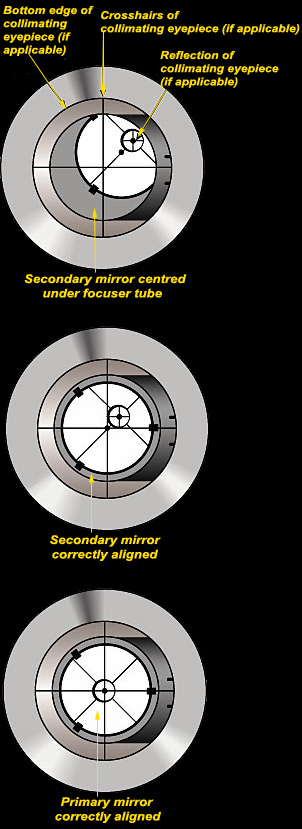 5. Make sure the secondary mirror is tilted so its elliptical shape is at a 45 degree angle, as seen through the empty focuser. (Again, your scope’s instructions or this guide will tell you what to adjust to do this.) As hard as this sounds, it’s actually not that tricky: You’ll have this mirror angled at 45 degrees as seen through the focuser when it looks like a perfect circle. (If you’re somewhat lucky, this mirror will already be angled at 45 degrees.)
5. Make sure the secondary mirror is tilted so its elliptical shape is at a 45 degree angle, as seen through the empty focuser. (Again, your scope’s instructions or this guide will tell you what to adjust to do this.) As hard as this sounds, it’s actually not that tricky: You’ll have this mirror angled at 45 degrees as seen through the focuser when it looks like a perfect circle. (If you’re somewhat lucky, this mirror will already be angled at 45 degrees.)
6. Now that you have the secondary mirror taken care of, it’s time to see if the primary (large) mirror is properly-aligned: If everything’s aligned from the get-go OR if you’ve done your secondary mirror aligning and the primary is fine, you should see something like the example here at far-right.
7. If you see something like the middle example at right, you’ll need to adjust the screws the the base of the main scope tube (not the screws or clips the hold the mirror in the tube – usually the adjusting screws are the larger set, but check your instruction manual to be sure.)
Turn one of each of the three adjustment screws at a time to get the image of the secondary mirror centred in the reflection of the primary (the primary mirror is white in the diagrams at right.)
ALMOST DONE…
To help in collimation, many primary mirrors have a tiny (a few mm) black ring in the centre.
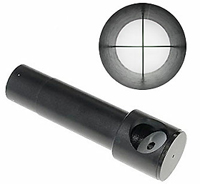 If desired, you can buy a collimating eyepiece for about $30. Such an “adjusting eyepiece” has a handy pair of crosshairs (seen as an “x” in the examples above, right) that makes this final step even easier.
If desired, you can buy a collimating eyepiece for about $30. Such an “adjusting eyepiece” has a handy pair of crosshairs (seen as an “x” in the examples above, right) that makes this final step even easier.
That’s it!
You should now be ready to use your telescope at night, when you can do a few final optional ultra-fine-tuning tests.
Before you step back inside, and while it’s still light out, see if you need to redo the finderscope adjustment chronicled at the top of this page.
If you’re stuck on any of the steps above, or just want a more detailed description, check out the extended version of this guide at Sky & Telescope
give tips how to use magnifieng power
Sure thing Maghil – I’ll try to put this in more sections of the site…It’s the eyepiece that determines a telescopes magnifying power: For high power (for viewing details on planets and the Moon, for e.g.) use the smallest size focal length (i.e. a 5 or 10 mm eyepiece). For low power (much more desirable for the bright, wide angle views it gives for large, faint deep space objects like galaxies and nebulas) use an eyepiece with a higher-number focal length (like 20, 30, or 40 mm.) If you just have the eyepieces your telescope came with, you most likely have a 10 mm eyepiece and a 20 or 25 mm eyepiece. Rule of thumb: use the 10 mm for planets and high-power views of the Moon, and use the 20 / 25 mm one for everything else.